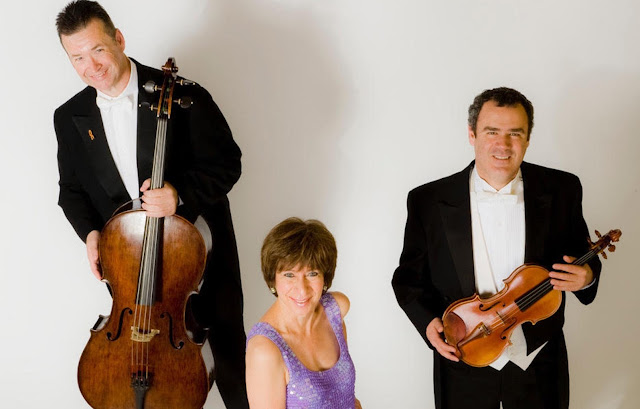 |
| The Pacific Trio: l-r John Walz, cello; Edith Orloff, piano; Roger Wilkie, violin. |
REVIEW
The Pacific Trio, South Bay Chamber Music Society, Pacific Unitarian Church, Rancho Palos Verdes
DAVID J BROWN
Given the pre-eminence of Beethoven, Brahms, Schubert, and Schumann in the piano trio genre, not to mention the predilections of South Bay performers and audiences, it was quite a surprise to see a local piano trio recital program announced that did not include works by any of these illustrious names, nor indeed anything by Mozart, Haydn, Mendelssohn, or Dvořák.
But then, with the performers in question being the long-established Pacific Trio (Roger Wilkie, violin; John Walz, cello; Edith Orloff, piano), the breadth of whose repertoire is well known, it was not a surprise that the program they presented for the South Bay Chamber Music Society’s January concert was full enough of variety and interest for no-one to have regretted the absence of any of the above-listed masters.
 |
| Joaquín Turina. |
Among these are three piano trios, one (unnumbered) from his student years and two written in his maturity. In the hands of the Pacific Trio, Turina’s 1933 Piano Trio No. 2 in B Minor, Op. 76 proved to be an extraordinarily immediate and attractive work which managed to convey an expansive, unfettered romantic tunefulness within a remarkably concise compass, its three movements all over in around 16 minutes.
Just as concise was the First Piano Trio, Op. 24 of Robert Muczynski, composed in 1966-67, in which the sun-drenched Mediterranean sensibility of the Turina was replaced, in the first of its four movements, by jazz-inflected, hard-edged energy enclosing a brief, somber, central section. An equally energetic, gnomically brief Allegro giocoso followed, not as uncomplicatedly cheerful as the marking might suggest, ending dismissively on a seemingly sour dissonance.
 |
| Robert Muczynski. |
Muczynski’s music is far from unknown to South Bay chamber musicians (see reviews of two previous concerts here and here), but for me the major pleasure of the concert lay in the single work that occupied the second half, Bedřich Smetana’s Piano Trio in G minor, Op. 15, composed in 1855 at the age of 31.
Any view of Smetana that is bounded by his reputation as a composer of Bohemian nationalist comic opera and romantic orchestral tone-poems gets a severe buffeting from an encounter with this astonishingly intense and personal work—his first real masterpiece, though its finale does incorporate elements of a piano sonata in the same key written some years earlier.
As the admirable downloadable program note by Saagar Asnani of UC Berleley made clear, the trio memorializes Smetana’s eldest daughter Bedřiška, who died that year at the age of four—and if ever there was an instance of tragedy sublimated into great art, this is one. All three instruments, singly and collectively, are pushed to their limits by a score laden with detailed markings from a composer visibly determined to use every resource for maximum expressiveness.
 |
| Oil portrait of Smetana in 1854. |
The second movement begins Allegro, ma non agitato with a tripping, somewhat Mendelssohnian-fairy idea, and its role as a scherzo-and-trio seems assured by the arrival of a contrasting Andante section, complete with first-half and second-half repeats, before a return to Tempo I. But this seemingly regular “trio” is also labeled Alternativo I, and just when the movement seems heading for a conventional end it plunges downward to Alternativo II, Maestoso, which amounts to an intercalated march-like slow movement that completely alters and expands the overall expressive range, before the opening tripping theme does finally return.
As for the finale, that passes from a furiously rhythmic Presto—derived from that earlier piano sonata—through various episodes, including another funeral march, which incorporate a second theme on the cello derived in part from its counterpart in the first movement. In the final climax the three instruments, straining it seems for truly orchestral weight, give this theme a positively Tchaikovskian passion and intensity, before a scurried fortissimo conclusion fools no-one into believing it any kind of “happy ending.”
The Pacific Trio fully matched the breadth and intensity of this masterpiece with their marvelously committed performance, after which no encore was needed to dispel the atmosphere they had generated for the hugely enthusiastic audience.
---ooo---
South Bay Chamber Music Society, LA Harbor College/ Pacific Unitarian Church, Friday/Sunday, 27/29 January, 2023.
Images: Pacific Trio: artists' website; Turina: Seattle Chamber Music Society; Muczynski: Theodore Presser; Smetana: Wikimedia Commons.
If you found this review to be useful, interesting, or informative, please feel free to Buy Me A Coffee!













No comments:
Post a Comment